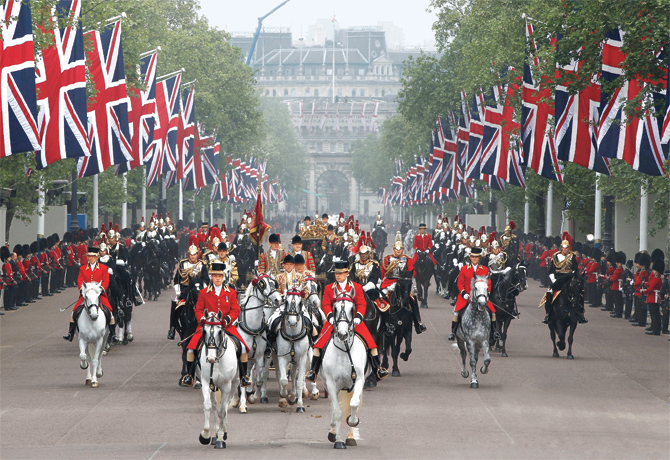
A million people gathered for a glimpse of the 2011 wedding procession of Prince William and Catherine Middleton
It was a year that drove home one lesson with unusual brutality: Nothing lasts forever, no matter how solid it looks. In 2011 popular anger swept away dictatorial regimes across the Middle East and dysfunctional governments in Europe. The Occupy movement rattled authorities in the U.S. and found raucous echoes around the globe. Fury at austerity budgets sent millions more to the barricades. In London and other parts of England, for five sultry nights, there were riots. From Athens to Moscow, one impulse, often inchoate, brought people onto the street: to wrest power from institutions.
Yet in the midst of all that, the United Kingdom's biggest demonstration of popular opinion, on April 29, indicated that at least one institution still commanded wide respect. In the chill of predawn, crowds converged on the capital to participate in an event that promised to be a piece of history. These people, a million or more, came not in anger but in optimism, to cheer an ancient organization putting on the pomp to observe a traditional rite. They came to celebrate the wedding of Prince William Arthur Philip Louis, the second-in-line to the British throne, to Catherine Elizabeth Middleton, a commoner elevated through their marriage to Duchess of Cambridge and to a leading position to become, one day, Queen.
The royal wedding, and the celebration in 2012 of Elizabeth II's Diamond Jubilee, her 60th year on the throne, mark something of a comeback for the Windsor dynasty, which just 20 years ago appeared irretrievably tainted by scandal and divorce. Things looked as if they couldn't get worse, but they did, in 1997, with the death of Princess Diana. For the royals, however, comebacks run in the family. The most extraordinary characteristic of the extraordinary phenomenon that is Britain's monarchy is its ability to endure and renew. Since Charles II was installed on the throne in 1660, at the end of an 11-year experiment in republicanism that started with the decapitation of his father on the orders of Parliament, kings and queens have kept their heads and acted as heads of state. Their survival has relied on a willingness to adapt to public opinion without fatally undermining the idea that royals are different from most folk — for the people, yet above the people.
No monarch has faced down greater existential challenges or perfected the technique of quiet adjustment to shifting realities with greater skill than the current Queen. The throngs that packed central London to see her grandson and his bride may have been caught up in the romance of a story sprinkled with the residual stardust of the groom's iconic mother and the fairy-tale plot line of a nice but ordinary girl snaring a prince; but they would not have turned up at all if not for the Queen's achievement in navigating more than half a century of tumult.
Her Diamond Jubilee year opened with no letup in the popular unrest that in the previous year had dismantled seemingly impregnable establishments. The United Kingdom itself could be imperiled as Scottish nationalists look forward to a 2014 referendum on independence. Yet those same nationalists have pledged to keep Elizabeth II as head of state whatever the outcome of the vote, and there are festivities planned on both sides of the border to mark the Queen's Jubilee. During an extended holiday weekend in June, the focus will return to London with a flotilla of 1,000 boats expected to accompany the sovereign's barge along the Thames, a concert at the gates of Buckingham Palace, a carriage procession to a thanksgiving service at St. Paul's Cathedral and, in an oddly sci-fi touch, the Queen will trigger a giant laser to light the last in a series of beacons to be illuminated across the U.K.
Britain's anti-monarchists — and there are more than a few, around a fifth of Britons, according to polls, with 20,000 of them signed up as supporters of the pressure group Republic — are preparing to celebrate too. For them the Jubilee presages the beginning of the end of the Elizabethan age and the eventual transition to a less sure-footed monarch.
In 1936, the monarchy survived the abdication of Edward VIII, who gave up the throne to marry the American divorcée Wallis Simpson. Indeed, the monarchy emerged stronger for it. That says something about where the two biggest risks to the institution reside: Any crisis raises questions about its continued existence, and it is only as good as its leader. King George VI, Edward's successor, stilled the questions raised by the abdication by proving far better suited to the kingship than his capricius brother, courageously overcoming his famous stammer to articulate a vision of national unity in a time of war. His daughter Elizabeth II has only rarely put a foot wrong. Her son and heir, the Prince of Wales, has not always appeared so deft.